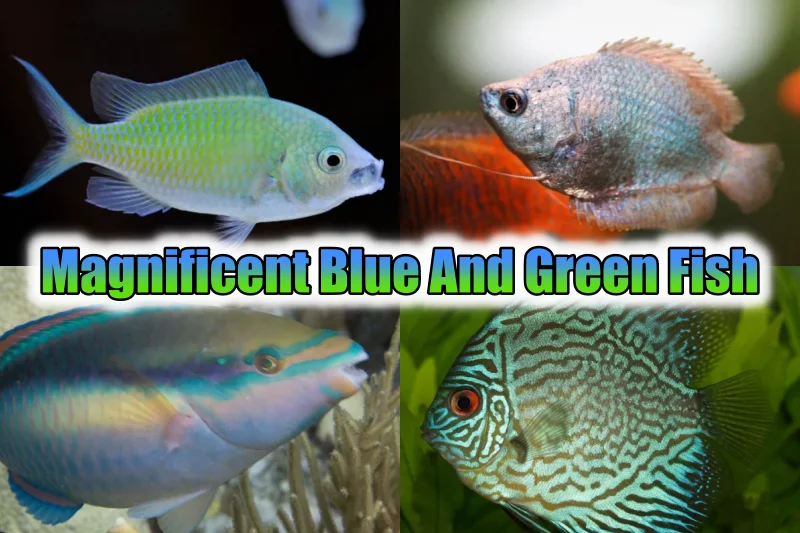The aquatic world is bigger than we thought. We can’t even imagine how many species and animals are living in the oceans and rivers. We only know some of the types of fish and aquatic animals. Have you ever thought about fish of blue and green color? Today we are going to explore the world of blue and green fish.
Here is the list:
14 Mesmerizing Blue and Green Fish
1. Blue Green Chromis

| Scientific name | Chromis viridis |
| Diet | Zooplankton, algae, copepods, artemia |
| Size | 1-10 cm |
| Location | Red Sea, the Gulf of Aden, Eastern Africa, Madagascar, Seychelles, the Persian Gulf, the Arabian Sea, the Maldives, Sri Lanka, the Andaman Sea, Australia, and Indonesia |
Chromis viridis is a blue-green damselfish species with iridescent apple-green and light blue fins. It can grow up to 1–10 cm. This fish has 12 dorsal rays, among them 9–11 soft dorsal rays.
The fish has two anal spines and 9–11 anal soft rays. It feeds on phytoplankton, zooplankton, algae, copepods, artemia, and amphipods. Also, it feeds on eggs that fail to hatch and feeds by ram-jawing. Chromis viridis schools in aggregations around Acropora coral heads.
2. Blue guppy fish
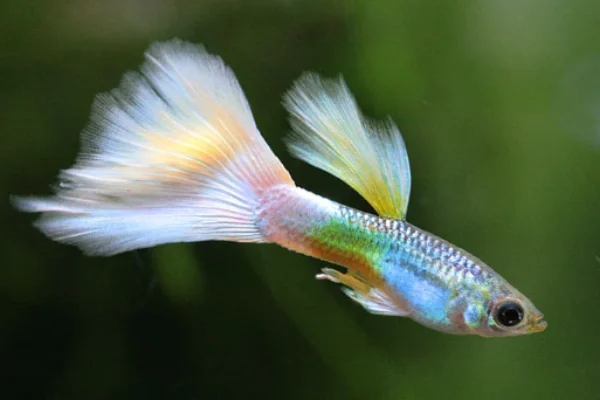
| Scientific name | Poecilia reticulata |
| Diet | Brine shrimp, daphnia, and bloodworms |
| Size | 3.8-5 cm |
| Location | Central and South America |
The Moscow Blue-Green Guppy has a striking blue-green coloration. With a lifespan of up to 2 years, these small blue and green fish are easy to care for and suitable for beginners.
They are omnivores and should be fed a varied diet of plant-based and protein-rich foods, including high-quality flakes, pellets, and frozen or live foods like brine shrimp, daphnia, and bloodworms.
Determining the sex of a Moscow Blue Green Guppy fish is easy by examining its fins. Male guppies have a more elongated anal fin, while females have a rounder fin. Males are brighter and have a more elongated anal fin.
Breeding and spawning the Moscow Blue Green Guppy fish is an enjoyable experience for aquarium enthusiasts, as they are livebearers, giving birth to live young rather than laying eggs. The gestation period is approximately 4 weeks, and females can give birth to 20 to 40 fry per litter.
3. Queen parrot fish

| Scientific name | Scarus vetula |
| Diet | Reef, scrap plants, and algae |
| Size | 25-60 cm |
| Location | West Atlantic Ocean, the Caribbean Sea, and the southern Gulf of Mexico |
Adult queen parrotfishes are heavy-bodied fish with fusiform bodies and beak-like mouths, growing to 60 cm. They have two different color phases: reddish-brown or grayish-brown, with a paler head and white lateral stripe.
Females are reddish-brown or grayish-brown, while larger males become pale bluish-green, with blue spots near the mouth, yellowish streaks between mouth and eye, and pale blue bars on pectoral fins. The male fish have blue and green colors.
4. Dwarf gourami
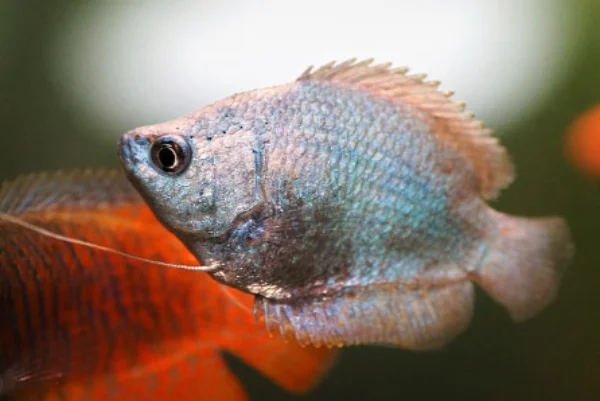
| Scientific name | Trichogaster lalius |
| Diet | Small insect, and larvae on water surface |
| Size | 8.8 cm |
| Location | Pakistan, India, and Bangladesh |
Dwarf gourami is found in slow-moving waters in rivulets, streams, and lakes. It can reach a length of 8.8 cm. This blue and green fish has diagonal stripes of alternating blue and red colors.
Male gouramis have a silvery color, while females have a pointed dorsal fin. They carry touch-sensitive cells on their thread-like pelvic fins. Dwarf gouramis sold in fish stores may be solid-colored captive-bred color morphs of the same species.
Similar to archerfish, they can project a stream of water from their mouth to hunt prey above the surface, reaching a maximum distance of approximately 5 cm.
5. Lake Kutubu Rainbowfish
| Scientific name | Melanotaenia lacustris |
| Diet | Small crustaceans, insect larvae, and algae |
| Size | 12 cm |
| Location | New Guinea |
The Lake Kutubu Turquoise Rainbowfish is a unique fish species with a narrow, triangular head. The fish had large eyes and impressive dorsal fins. They are known for their exotic dark blue hue, which fades into green, silver, or yellow at the bottom.
These fish are found in Papua New Guinea’s remote Lake Kutubu, where 10 of the 14 species are endemic. They are unfussy and omnivorous and can be found in various foods, including dried, frozen, and live.
They are peaceful but can disturb smaller or slower-moving fish due to their rapid movements and large size.
6. Blue Discus
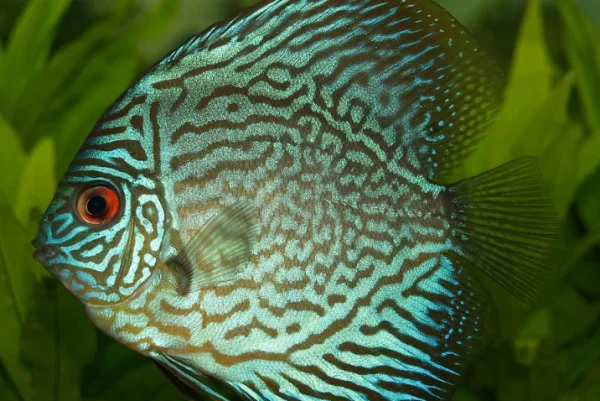
| Scientific name | Symphysodon aequifasciatus |
| Diet | Bloodworms, brine shrimp, krill and daphnia |
| Size | 12-23 cm |
| Location | South America |
Symphysodon aequifasciatus, also known as the blue discus or brown discus, is a cichlid native to rivers in the eastern and central Amazon Basin. It is found in black, clear, and whitewater, but prefers lentic habitats like floodplains and flooded forests.
The species is primarily found in water with a high temperature and pH of 25–32 °C. Its body is strongly compressed and nearly circular, with dorsal and anal fins extending along the body.
The discus’ colors and patterns are striking, with background colors ranging from brown to orange and blue. This blue fish has a green-apple shade near its gills.
7. Blue and green betta fish
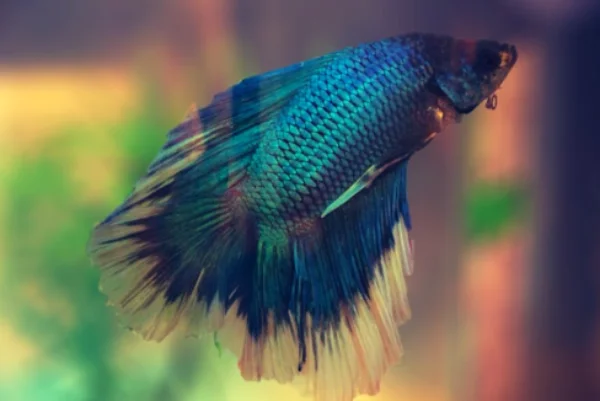
| Scientific name | Betta splendens |
| Diet | Insects and invertebrates |
| Size | 6–8 cm |
| Location | Southeast Asia |
B. splendens, also known as the betta, is a freshwater fish native to Southeast Asia known for its vibrant colors and large fins. It is naturally carnivorous, feeding on zooplankton, crustaceans, and aquatic insects.
In captivity, Siamese fighting fish have been selectively bred to display a variety of colors and tail types. The fish is native to Cambodia, Laos, Myanmar, Malaysia, Indonesia, Thailand, and Vietnam.
8. Blue neon peacock Cichlid
| Scientific name | Aulonocara stuartgranti |
| Diet | Larvae, crustaceans, small insects, daphnia, and brine shrimp |
| Size | 15 cm |
| Location | Africa |
Blue Neon Peacocks, similar to Flavescent Peacocks, have blue fins and a bright yellow body with green strips. Males have a blue face and fins, while females may have a subtle blue or yellow sheen.
They can be blue toward the posterior half. This fish had aggressive behavior. These fish are mostly found in the region of Lake Malawi, Africa. This blue and green fish feeds on flake or pellet.
9. Green Terror Cichlid Fish
| Scientific name | Andinoacara rivulatus |
| Diet | Crustaceans, insects, and worms |
| Size | 12-30 cm |
| Location | South America |
The green terror is a colorful freshwater fish in the cichlid family, originating from the Pacific side of South America. It is polymorphic and has white or gold-orange edging on its tail and dorsal fins.
Young fish have a silvery-blue hue that deepens to metallic green as they grow older. Males can reach lengths of up to 30 cm, while females are sexually mature at around 12 cm.
It is popular in the aquarium trade for its hardiness and aesthetic appeal. A. rivulatus is cunning and can survive with larger cichlids, but it can consume any animal whose dimensions are inferior to its fully expanded jaw.
10. Umbrella Cichild
| Scientific name | Apistogramma borelli |
| Diet | Insects and crustaceans |
| Size | 5-6.5 cm |
| Location | Southern Brazil, Paraguay, Argentina, and Uruguay |
The umbrella cichlid, also known as the Buenos Aires tetra, is a freshwater fish native to southern Brazil, Paraguay, and northern Argentina. It lives in creeks and tributaries of the Rio Paraguay and lower Rio Paraná basins.
Its maximum standard length is 6.5 cm for males and 5 cm for females. This fish is popular for its bright colors and playful personality, making it a popular aquarium fish.
It is easy to care for and is a good choice for beginner aquarists. The umbrella cichlid’s bright colors and playful personality make it a popular choice for aquariums.
11. Bermuda blue fish
| Scientific name | Holacanthus bermudensis |
| Diet | Tunicates, corals, and algae |
| Size | ~45 cm |
| Location | western Atlantic, North Carolina, Bermuda, Bahamas, Florida, Gulf of Mexico, Yucatan, Mexico, Puerto Rico and Virgin Islands |
Another blue and green fish species is Holacanthus bermudensis, also known as the blue angelfish or Bermuda blue angelfish, is a marine angelfish species in the Pomacanthidae family.
It has a deep, oval-shaped body with a short snout and small mouth with small teeth. Juveniles are yellowish and have vivid yellow fins, while adults have a vivid greenish-yellow face and blue highlights.
They have blue pectoral fins, yellow margins, and yellow streamers. The dorsal fin contains 15 spines and 19-21 soft rays, while the anal fin has 3 spines and 20-21 soft rays. The species can reach a maximum length of 45 cm.
12. Queen anglefish
| Scientific name | Pomacanthus semicirculatus |
| Diet | Algae, tunicates and sponges |
| Size | 8-16 cm |
| Location | eastern Africa, southern Red Sea coast, South Africa, Indian ocean, Pacific Oceans, Fiji, Tonga, Samoa, Japan, and Australia |
Pomacanthus semicirculatus is a marine angelfish species found in the Indo-West Pacific Ocean. It is a ray-finned fish with distinct adult and juvenile characteristics.
Adults are brownish green with blue scales and blue margins, while juveniles are blue-black with narrow white stripes. They gradually adopt adult coloration when they reach 8 to 16 centimeters.
The dorsal fin contains 13 spines and 20-23 soft rays, while the anal fin contains 3 spines and 18-22 soft rays. The species can reach a maximum length of 40 centimeters (16 in). It occasionally enters the aquarium trade.
13. Blue green puller fish
| Scientific name | Chromis atripectoralis |
| Diet | Copepods, amphipods, and zoea. |
| Size | ~12 cm |
| Location | Indian, south Pacific Oceans, east African coasts, and French Polynesia |
The black-axil chromis, also known as the blackfin chromis or blue-green puller, is a tropical Indo-Pacific damselfish that can reach almost 12 centimeters in length. It inhabits lagoons and reefs after settlement in the late-larval stage, feeding on copepods, amphipods, and zoea. The fish has a blue-green head and dorsal side, white to white-gray belly, and an inner and outer row of conical, widely spaced teeth.
14. Stark’s tilefish
| Scientific name | Hoplolatilus starcki |
| Diet | zooplankton |
| Size | ~15.5 cm |
| Location | Indian ocean, and Pacific Oceans |
Hoplolatilus starcki is a marine ray-finned tilefish native to the central Indo-Pacific ocean. It has a thin, elongated body and this blue and green fish can grow up to a maximum length of 15.5 cm. Adults are yellowish-brown to greenish, with wide yellow caudal fin lobes and vivid blue pectoral fins. Juveniles are sky blue, with a dorsal fin with 8 spines and soft rays, and an anal fin with 2 spines and 15-16 soft rays. this also known as purple-headed sand tilefish, Stark’s tilefish or bluehead tilefish.
Conclusion
These are some of the blue and green fish. All of them have a beautiful blend of colors. They all show the creativity of nature and how nature makes everything beautiful and different in its own way. This is it for today, we will be back with some more informative knowledge really soon. Till then, stay tuned with How It See.
Also Read:

As a content writer, I like to write about different niches. I have a curiosity about nature and animals. And like to learn about them. Through my writing, I like to share my experience and knowledge with you. I hope you are enjoying it too.
